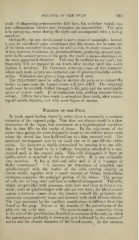Page 905 - My FlipBook
P. 905
POLYPUS OF THE PULP. 915
mode of diagnosing pericementitis fails here, for, as before stated, vio-
lent inflammation renders new formations an impossibility. The pain
is in paroxysms, worse during the night and accompanied with a boring
sensation.
Ordinarily, the new development is not a cause of neuralgia ; indeed,
it may be considered quite exceptional that this occurs, for in some one
of its forms secondary tissue may be said to exist in every mature tooth.
When, however, it assumes the granulated form, producing unequal pres-
sure on the sensory nerves of the pulp, the result is pain—oftentimes of
the most aggravated character. This may be confined to one tooth, but
frequently will be repeated in one tooth after another until the entire
denture is involved. Dr. Garretson mentions a case of this character
where each tooth in turn was extracted, and all presented nodular calcifi-
cation. Schlenker also gives a large number of cases.
The TREATMENT must be either to destroy the pulp or to extract the
tooth ; in most cases the former course will give relief. The suspected
tooth must be carefully drilled through to the pulp and the usual appli-
cation of arsenic made. If devitalization fails, nothing remains but to
extract. . Efforts have been made to reimplant these teeth, after remov-
ing all calcific deposits, and with some degree of success.
Polypus of the Pulp.
In teeth much broken down by caries there is necessarily a constant
irritation of the exposed pulp. This does not always result in a slow
destruction of the organ, but eventuates in a hypertrophied condition
that in time fills up the cavity of decay. In the experience of the
writer these polypi are more frequently found in the inferior molar teeth
where the croMu has been hollowed out to a thin external wall. The
increased development may be of small size or it may fill the entire
cavity. Its character is readily determined by pressing it to one side,
when it will be found to be a bulbous formation attached by a con-
stricted neck to the coronal pulp. This will distinguish it from an
epulis, M'hich is attached to the alveolar walls. It is not ordinarily
very sensitive. It has a dark-red color and is of a " spongy or
fleshy consistence." " It contains an abundance of roundish and
spindle-shaped cells, the bodies of the cells varying slightly in
extent, which, together with a small amount of fibrous intercellular
substance, comprise the principal portion of the tumor. The groups
of cells are in long rows and have a radiated arrangement. The cells,
which are provided with processes, unite here and there to form a net-
work ; rows of spindle-shaped cells also are met with ; the blood-vessels
pursue a tortuous course from the interior toward the periphery, are
numerous, comparatively large; and invested with thick fibrous sheaths.
The type presented by the capillary ramifications is different from that
found in the pulp. Nerves or the remains of the parenchyma of the
pul]-> are not to be seen The parenchymatous connective tissue
is the seat of the proliferation described as sarcoma of the pulp, in AAhich
the parenchyma gradually is destroyed, as is indicated by the absence of
nerves and the altered character of the blood-vessels. As the sarcoma


